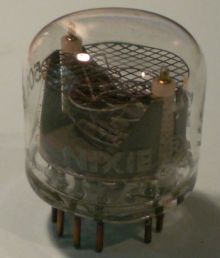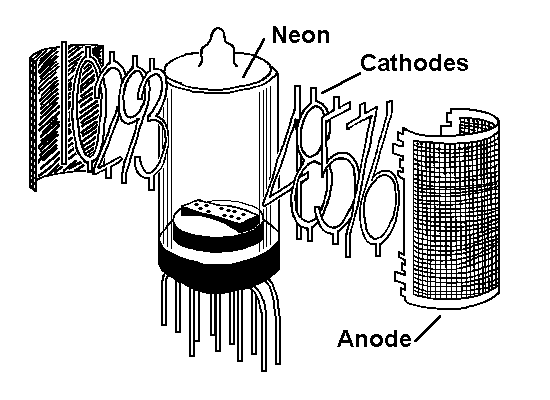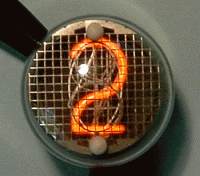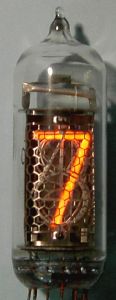www.jb-electronics.de » Elektronik » Nixie-Röhren » Was sind Nixie-Röhren?
Was sind Nixie-Röhren?
Nun, der eigentliche Name Nixie setzt sich zusammen aus Numeric Indicator eXperimental No I, was zusammengesetzt NIXI ergibt. Eigentlich ist dies nur die Bezeichnung für diese Art von Anzeigeröhren der Firma Burroughs, die diesen Markennamen 1956 prägte; dennoch hat sich Nixie als gängiger Name durchgesetzt. Siehe hier ein Foto der B-5092 von Burroughs, die diesen Markennamen aufgedruckt trägt:

Das Funktionsprinzip der Nixie ist bemerkenswerterweise schon seit den Zwanziger Jahren bekannt. Doch ihre Blütezeit erlebten die Anzeigeröhren erst beim Aufkommen der digitalen Signalverarbeitung in den Fünfzigern.
Bis in die Siebziger waren Nixies die gängigen Anzeigeinstrumente für numerische Werte. Damals wurden Nixies für jede erdenklichen Zwecke eingesetzt, wie etwa in Messgeräten und Rechnern. Heutzutage findet man sie mit viel Glück noch in alten Messgeräten und Uhren auf dem Sperrmüll oder auf dem Trödel. Die Ära der Nixies ging mit der Erfindung der Vakuum-Fluoreszenz-Displays (VFDs) und später der 7-Segment-LED-Displays zu Ende. Dennoch sind viele Bastler (darunter ich selbst) immer noch vom Leuchtbild der Nixies beeidruckt, und fertigen zahllose Projekte mit ihnen an.
Da ein Bild oft mehr als ein paar tausend Worte sagt, hier noch eine kleine Grafik, die die (Grund-)Funktionsweise einer Nixie erklärt:

Eine Nixie besteht im Grunde also nur aus einem gasgefüllten Glaskolben (meistens mit dem Edelgas Neon gefüllt), einem Anodenblech und mehreren Ziffern, die aus feinem Blech ausgestanzt wurden. Wenn also nun eine genügend hohe Spannung über einen Strombegrenzungswiderstand an der Anode angelegt wird und eine der Ziffern auf Masse gelegt wird, überzieht den Draht der Ziffer ein je nach Gastyp variierendes rotes bis oranges Gasentladungsleuchten ähnlich dem Prinzip bei der Glimmlampe:

Denn beim Anlegen einer genügend hohen Spannung verlassen Elektronen die Drahtziffern und wandern zum Anodenblech. Beim Übergang vom Metall zum Gas regen sie selbiges zum Leuchten an. Dabei werden auch oft mikroskopisch kleine Teile des Ziffernmaterials in der Röhre verteilt, da diese förmlich mit den Elektronen aus der Ziffer herausgeschleudert werden (ein Elektron erreicht beispielsweise bei 175V Betriebsspannung der Nixie ca. 3% der Lichtgeschwindigkeit, was schon enorm ist, wenn man sich das einmal vorstellt). Den beschriebenen Vorgang des Materialverteilens und die damit verbundene Verdunkelung der Röhre oder einzelner Ziffern bezeichnet man als Cathode poisoning - es ist im wahrsten Sinne des Wortes ein Kathodengift.
Es gibt zwei verschiedene Arten von Nixies. Zum einen die sogenannten Kopffüßler, wie Sie sie oben in Gestalt der IN-4 sehen können, und zum anderen die klassische senkrechte Variante, zum Beispiel die IN-14:

Leider werden Nixies heutzutage nicht mehr hergestellt, weshalb sie mit der Zeit immer rarer werden. Es gibt jedoch einige Webseiten, auf denen man Nixies zu relativ günstigen Preisen erstehen kann. Adressen sind unter Links zu finden.
